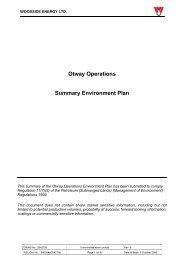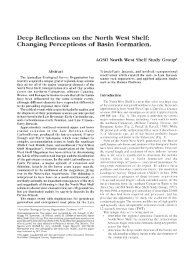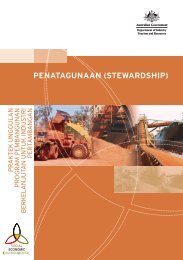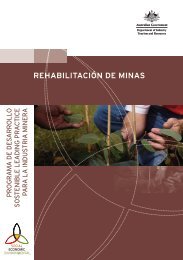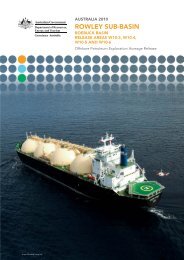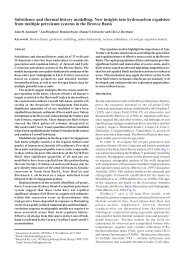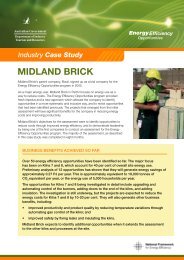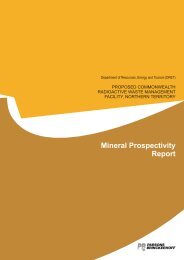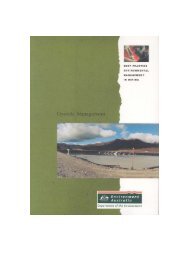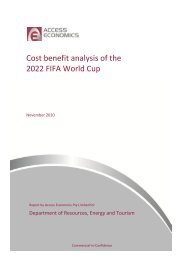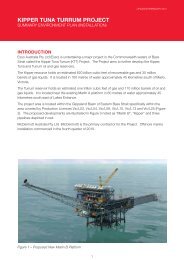A guide to leading practice sustainable development in mining
A guide to leading practice sustainable development in mining
A guide to leading practice sustainable development in mining
You also want an ePaper? Increase the reach of your titles
YUMPU automatically turns print PDFs into web optimized ePapers that Google loves.
Table 2. Typical water quality issues for the m<strong>in</strong><strong>in</strong>g <strong>in</strong>dustry<br />
M<strong>in</strong>e-life stage Water quality related<br />
activity<br />
Exploration Erosion from temporary roads<br />
Runoff of drill<strong>in</strong>g fluids,<br />
petroleum products from drill<br />
pad construction and operation,<br />
camp wastes.<br />
Resource <strong>development</strong> and<br />
design<br />
M<strong>in</strong><strong>in</strong>g, m<strong>in</strong>erals process<strong>in</strong>g and<br />
ref<strong>in</strong><strong>in</strong>g<br />
Develop<strong>in</strong>g water management<br />
plan.<br />
Prepar<strong>in</strong>g EIS.<br />
Discharge management.<br />
Possible acid-rock dra<strong>in</strong>age.<br />
Tail<strong>in</strong>gs management.<br />
Solid waste management.<br />
Action<br />
Initial basel<strong>in</strong>e moni<strong>to</strong>r<strong>in</strong>g<br />
program developed (weather<br />
station, several water quality/<br />
biology sites, water flows).<br />
Basel<strong>in</strong>e <strong>in</strong>ven<strong>to</strong>ry and<br />
moni<strong>to</strong>r<strong>in</strong>g at key sites, <strong>in</strong>clud<strong>in</strong>g<br />
those <strong>in</strong> reference catchment(s),<br />
implemented for water quality<br />
and ecological features.<br />
On-site moni<strong>to</strong>r<strong>in</strong>g (discharges,<br />
s<strong>to</strong>rage and hold<strong>in</strong>g dams,<br />
groundwater)<br />
Off-site moni<strong>to</strong>r<strong>in</strong>g of receiv<strong>in</strong>g<br />
system and reference sites<br />
(quality, flows, biology).<br />
Water management plan<br />
implemented.<br />
Rehabilitation Management of onsite water. On-go<strong>in</strong>g assessment of impacts.<br />
Closure and post-m<strong>in</strong><strong>in</strong>g Consider<strong>in</strong>g all possible future<br />
impacts (e.g. acid rock dra<strong>in</strong>age).<br />
Cont<strong>in</strong>ued off-site and onsite<br />
moni<strong>to</strong>r<strong>in</strong>g.<br />
Shipp<strong>in</strong>g of products Possible spillage, dust control Moni<strong>to</strong>r<strong>in</strong>g of receiv<strong>in</strong>g system<br />
and reference sites (quality,<br />
flows, biology).<br />
The Cadia case study illustrates the importance of collect<strong>in</strong>g data dur<strong>in</strong>g the EIA<br />
and feasibility stages of a m<strong>in</strong><strong>in</strong>g project. The Cadia Hill gold m<strong>in</strong>e was approved on<br />
6 September 1996 with several conditions. These conditions related <strong>to</strong> the release<br />
of water from Cadiangullong Dam and the ma<strong>in</strong>tenance of flows <strong>in</strong> Cadiangullong<br />
Creek <strong>to</strong> provide environmental flows and as well meet the requirements of<br />
downstream users.<br />
Limited basel<strong>in</strong>e data on the aquatic ecology and hydrology of Cadiangullong Creek<br />
was available at the commencement of the project and additional data was collected<br />
as part of the environmental impact studies. At the time of the construction of the<br />
Cadiangullong Dam, empirically based processes for determ<strong>in</strong><strong>in</strong>g the riparian and<br />
environmental flows needed <strong>to</strong> ma<strong>in</strong>ta<strong>in</strong> river<strong>in</strong>e ecosystem <strong>in</strong>tegrity were <strong>in</strong> their<br />
<strong>in</strong>fancy <strong>in</strong> Australia. Virtually no research had been undertaken on these issues <strong>in</strong><br />
small upland streams.<br />
Additional research was required <strong>to</strong> be undertaken <strong>to</strong> assess and model the<br />
effects of chang<strong>in</strong>g flow regimes (drought, low, medium and flood) on <strong>in</strong> stream<br />
and riparian environments and their associated organisms. The Environmental<br />
Studies Unit at Charles Sturt University was contracted by Cadia <strong>to</strong> design and<br />
carry out appropriate research <strong>to</strong> satisfy the requirements of this condition. The<br />
researchers concluded that there was no evidence of a decl<strong>in</strong>e <strong>in</strong> stream diversity<br />
and that under the range of flows available dur<strong>in</strong>g the study period, a very high<br />
58 LEADING PRACTICE SUSTAINABLE DEVELOPMENT PROGRAM FOR THE MINING INDUSTRY






